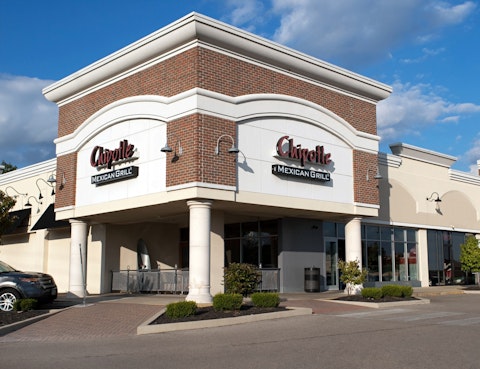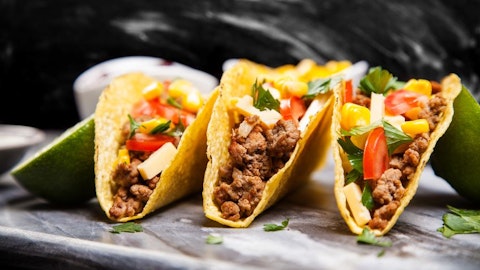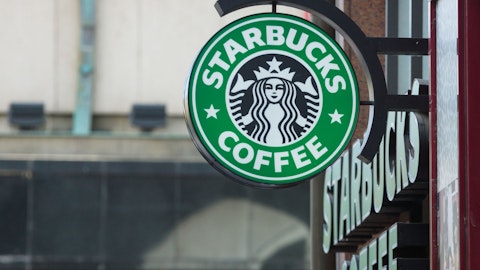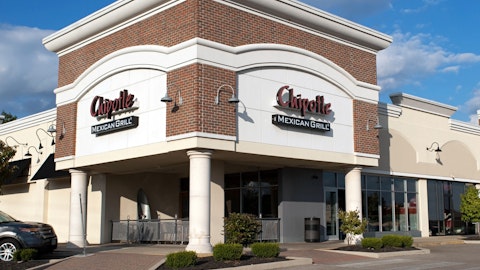Chipotle Mexican Grill, Inc. (NYSE:CMG) Q4 2022 Earnings Call Transcript February 7, 2023
Operator: Good day and welcome to the Chipotle Mexican Grill Fourth Quarter 2022 Results Conference Call. All participants will be in listen-only mode. After today’s presentation, there will be an opportunity to ask questions. Please note this event is being recorded. I would now like to turn the conference over to Cindy Olsen, Head of Investor Relations and Strategy. Please go ahead.
Cindy Olsen: Hello, everyone, and welcome to our fourth quarter fiscal 2022 earnings call. By now, you should have access to our earnings press release. If not, it may be found on our Investor Relations website at ir.chipotle.com. I will begin by reminding you that certain statements and projections made in this presentation about our future business and financial results constitute forward-looking statements. These are based on management’s current business and market expectations, and our actual results could differ materially from those projected in the forward-looking statements. Please see the risk factors contained in our annual report on Form 10-K and in our Form 10-Qs for a discussion of risks that may cause our actual results to vary from these forward-looking statements.
Our discussions today will include non-GAAP financial measures. A reconciliation to GAAP measures can be found via the link included on the presentation page within the Investor Relations section of our website. We will start today’s call with prepared remarks from Brian Niccol, Chairman and Chief Executive Officer; and Jack Hartung, Chief Financial and Administrative Officer; after which we will take your questions. Our entire executive leadership team is available during the Q&A session. And with that, I will turn the call over to Brian.
Brian Niccol: Thanks, Cindy, and good afternoon, everyone. We delivered another year of strong results in 2022, expanding AUVs and restaurant-level margin despite facing one of the highest inflationary periods on record and an uncertain macro environment. These results demonstrate Chipotle’s resiliency driven by our talented teams, delicious food made fresh daily, convenience, customization, and of course, our tremendous value. For the year, sales grew 14% to reach $8.6 billion driven by an 8% comp. Digital sales represented 39% of sales. Restaurant-level margin was 23.9%, an increase of 130 basis points year-over-year. Adjusted diluted EPS was $32.78, representing 29% growth over last year, and we opened 236 new restaurants, including 202 Chipotlanes.
Turning to the fourth quarter. While we are pleased with our overall growth, our results were impacted by a few factors that were unique to the quarter, including a lower-than-expected benefit from garlic guajillo steak and a headwind from loyalty accounting. For the quarter, sales grew 11% to $2.2 billion driven by a 5.6% comp. In-store sales grew by 18% over last year. Digital sales continue to represent 37% of sales. Restaurant-level margin was 24%, an increase of 380 basis points year-over-year. Adjusted diluted EPS was $8.29, representing 49% growth over last year, and we opened 100 new restaurants, including 90 Chipotlanes. Our transaction trends improved throughout the quarter as we lapped brisket, and I’m pleased to report that our underlying trends have further improved entering 2023, with transaction trends turning positive.
For the first quarter, we anticipate comps in the high single-digit range. Our focus on getting back to the basics and running great restaurants is beginning to pay off, and we plan to further emphasize this in 2023. Additionally, we will continue to build upon our five key strategies that will help us to win today while we create the future. Now let me provide an update on each of these strategies, which include: number one, running successful restaurants with a people-accountable culture that provides great food with integrity while delivering exceptional in-restaurant and digital experiences; number two, sustaining world-class people leadership by developing and retaining diverse talent at every level; number three, amplifying technology and innovation to drive growth and productivity at our restaurants and support centers; number four, making the brand visible, relevant and loved to improve overall guest engagement; and number five, expanding access and convenience by accelerating new restaurant openings.
Beginning with our restaurants. As we discussed on the last call, Chipotle is a restaurant business with high standards, and it is critical that we treasure the guest and delivering an exceptional experience, including great culinary and in-restaurant execution. During the pandemic, there were unforeseen challenges, such as supply outages, staffing challenges and exclusions from COVID that resulted in a need to create workarounds. We have been eliminating the workarounds and reestablishing operational standards with Project Square One while continuing to build a culture of excellence in every aspect of our business. This means ensuring all ingredients are in stock, that our teams are fully staffed and properly deployed during peak periods to drive throughput, that our delicious food is prepped and cooked on time, that we are improving throughput on the frontline and improving on time and accuracy on the digital make-line; and of course, that we are delivering exceptional customer hospitality.
Project Square One has helped to lay the foundations, including training in each of these areas. We are also bringing back more shoulder-to-shoulder training. One thing that I believe everyone has learned from the pandemic is that virtual training is not the only tool needed. So we are reducing the amount of virtual training and bringing new crew members into our restaurants sooner for on-the-job training. This helps to accelerate onboarding and gives more confidence to our new crew members as they are learning by doing. Shoulder-to-shoulder training by experienced managers is an essential process. I’m also happy to see an improvement in turnover with December being one of our best months in the past two years for both hourly and salary turnover rates.
And our staffing levels continue to improve with 90% of our restaurants fully staffed. This, combined with better stability, leads to more experienced teams. When you combine this with Project Square One training for the past two quarters, positive signs are emerging across the operation. We are focused on operational excellence and have intensity and collaboration to achieve it, great people and great culinary drives performance. And speaking of great people, I’m proud to share that in 2022, we promoted over 22,000 people, surpassing 2021, and 90% of all restaurant management roles were internal promotions. And we have tremendous growth ahead. In 2023, to open our new restaurants, we will have the opportunity to promote over 1,800 hourly manager roles, over 255 GMs and over 40 field leadership positions.
And these numbers will continue to grow as we expand our restaurants by our targeted range of 8% to 10% per year. As we have said in the past, our goal is to be the employer of choice. In addition to career advancement opportunities, industry-leading benefits and competitive wages, we will continue to look for ways to improve the overall experience for our teams. We know one way is to continue to invest in technology and innovation. There are a couple of new stage gate initiatives that I’m excited to share along with an update on improvements to our app functionality. First, we are currently testing a new grill to improve the overall cooking process for our chicken and steak. The grill is much faster and has consistent execution, which lowers the learning curve significantly.
Importantly, we believe it maintains our high culinary standards and can cook the chicken and steak to perfection. We look forward to further validating it through our stage gate process. And second, you may remember that in the second quarter, we announced Hyphen as one of our first investments in our Cultivate Next Fund. Hyphen is a food service platform that automates the assembly of meals on the digital make-line and could help fulfill our promise to deliver on-time, accurate orders for our digital guests. This would allow our restaurant teams to focus more on our in-restaurant guests on the frontline, further improving throughput. I’m thrilled to share that together with Hyphen, we are developing our first automated digital make-line prototype, which we will test and learn on, and we expect to have it in our Cultivate center in the first half of this year.
Speaking of our digital business, it is over $3 billion in revenue and represents 39% of our sales, and we’re constantly looking for ways to improve the experience for our guests. Last quarter, we started testing advanced location-based technology to enhance our app functionality. For guests who opt in, the program can engage with Chipotle app users upon arrival to our restaurants and utilize real-time data to enhance their experience with order readiness messaging, wrong pickup location detection, reminders to scan the Chipotle Rewards QR code at checkout and more. The results from the stage gate process were very encouraging, including an improvement in delivery speed, a reduction in customers going to the wrong location and an improvement in the experience for our rewards guests, allowing them to quickly scan for their rewards points without impacting throughput.
As a result, we rolled it out nationwide last month. Moving on to making our brand more visible, more relevant and more loved. Our Real Food for Real Athletes platform has been a success as we partner with athletes of all levels who are fans of Chipotle and focus on helping them perform their best by providing proper nutrition through real food and real ingredients. During the fourth quarter, we teamed up with U.S. Men’s National Soccer Team stars, Christian Pulisic and Weston McKennie to showcase their journey to soccer’s biggest international tournament while featuring the athletes’ go-to orders in our app. We also continue to leverage social media to remain relevant with our consumers, especially Gen Z. This year, we surpassed 2 million TikTok followers, which to put into context rival some of the largest brands in the world and we were the first brand to launch on the new social media platform, BeReal.
Shifting to menu innovation. As we mentioned last quarter, 2023 will consist of one to two LTOs. I’m delighted to share that Chicken Al Pastor has been validated and ready to be rolled out in the near future. This new menu item is operationally simple to execute while still providing a new exciting flavor that drives transactions and sales. We also recently launched a new lineup of Lifestyle Bowls that cater to contemporary wellness habits of Gen Z and millennials. The lineup spans a wide range of healthy habits such as our Balanced Macros Bowl, our High Protein Bowl and our Grain Freedom Bowl. Lifestyle Bowls are a great way to show our customers that they can create balanced meals made with our existing ingredients that taste great and that they feel great eating.
Turning to our Rewards program. In 2022, we increased our rewards members by 20% to 31.6 million. Our program continues to get more sophisticated as we better understand who our members are and serve them with relevant content, targeted offers and gamified badging to help drive transactions. In 2022, 60% of our rewards program promotions were personalized, and we plan to increase this going forward. To drive engagement and enroll new members, we recently introduced Freepotle, which offers each rewards member 10 personalized free rewards throughout the year. Our fifth strategic pillar is to expand access, and our development team has done an outstanding job of navigating headwinds such as material shortages and permitting and inspection delays while successfully opening 236 new restaurants in 2022, including 202 Chipotlanes.
In fact, we opened 100 new restaurants in the fourth quarter, which was a record for the company. We also opened our 500th Chipotlane during the quarter as we expanded access and convenience through our unique digital drive-through format, and the performance of Chipotlanes continues to be strong. In fact, since we began opening Chipotles in 2018, our new restaurant productivity has improved by about 1,000 basis points. We plan to open 255 to 285 new restaurants in 2023 with over 80% including the Chipotlane. Within our 2023 expansion plans, we will accelerate new restaurant growth in Canada and continue to open restaurants at a measured pace in Europe. In Canada, we have built out a strong local field leadership team that works closely with our U.S. team to ensure best practices and a consistent culture, while adapting to local needs.
We are now ready for accelerated growth and plan to add around ten new restaurants in 2023, which will be the fastest development growth rate since we entered the Canadian market. We also remain encouraged by the performance in Europe despite a challenging macroeconomic backdrop. In 2023, we plan to add a few additional locations in the UK, and we are also rolling out our digital capabilities to further expand access. We remain optimistic about the growth opportunity, and we will continue to update on Europe’s progress of the stage-gate process along the way. In closing, I want to thank our restaurant and support center teams for another terrific year. Our focus on getting back to the basics is starting to pay off. Our teams are energized, and I’m excited to see further progress over the coming quarters.
We have a long growth runway ahead with the ability to more than double our restaurant count, grow AUVs beyond $3 million and expand margins. I believe we have the right team and strategy in place, and we will remain focused on meeting the standards of excellence that make Chipotle, Chipotle. And with that, I will turn it over to Jack.

Susan Law Cain / Shutterstock.com
Jack Hartung: Thanks, Brian. And good afternoon, everyone. Sales in the fourth quarter grew 11% year-over-year to reach $2.2 billion as comp sales grew 5.6%, which included about an 80 basis point headwind related to our loyalty program. In Q4 of each year, we reevaluate the estimated loyalty breakage for points that will expire. And this year, we decreased our estimate due to higher member engagement. Restaurant-level margin of 24% increased about 380 basis points compared to last year. In addition to loyalty program headwind, restaurant-level margin was impacted by a higher level of sick pay and medical claims in the quarter compared to our expectations. Earnings per share adjusted for unusual items was $8.29, representing 49% year-over-year growth.
The fourth quarter had unusual expenses related to legal expenses, our previously disclosed 2018 performance share modification and corporate restructuring. Turning to our sales outlook for 2023, as Brian mentioned, we’ve seen the transaction trends turn positive as we remain focused on delivering a great guest experience. January comps were in the low double digits. For Q1, factoring in momentum we’ve seen quarter-to-date as well as tougher comparisons as we move through the remainder of the quarter, we anticipate comp sales to be in the high single-digit range. While it’s difficult to forecast comps for the rest of the year, considering economic uncertainty, including the possibility of recession, we expect comps to moderate as we lap menu price increases in early Q2 and the middle of Q3.
I’ll now go through the key P&L line items, beginning with cost of sales. Cost of sales in the quarter were 29.3%, a decrease of about 230 basis points from last year. The benefit of menu price increases and lower avocado prices offset elevated costs across the board, most notably in dairy, tortillas, beans, rice and salsa. In Q1, we expect our cost of sales to be in the high-29% range due to higher prices across several items, including queso, salsa, spices and oil. Labor costs for the quarter were 25.6%, a decrease of about 80 basis points from last year. The benefit of sales leverage was somewhat offset by wage inflation in addition to higher-than-expected sick pay and medical claims. For Q1, we expect our labor cost to improve slightly, but remain in the mid-25% range, due to seasonally higher employee taxes as employee taxes start the year at an elevated level due to resetting of wage caps.
Other operating costs for the quarter were 15.7%, a decrease of about 60 basis points from last year. This decrease was driven by a decline in delivery expenses due to lower delivery sales as well as sales leverage, partially offset by higher costs across several expenses, including natural gas and maintenance and repairs. Marketing and promo costs for the quarter were 3.4%, 20 basis points below last year. In Q1, we expect marketing costs to be in the mid-3% range with the full year to come in around 3%. In Q1, other operating costs are expected to be in the low 15% range. G&A for the quarter was $135 million on a GAAP basis or $129 million on a non-GAAP basis, excluding $4 million in legal expenses, $1 million related to the previously disclosed modification to our 2018 performance shares and $1 million related to transformation expenses.
G&A also included $119 million in underlying G&A, $18 million related to noncash stock compensation, which includes a reduction in the estimated payout levels of our performance-based stock awards and was offset by $8 million reduction in performance-based bonus accruals. We expect our underlying G&A to be around $121 million in Q1 and continue to grow slightly thereafter as we make investments in technology and people to support ongoing growth. We anticipate stock comp will be around $25 million in Q1, although this amount could move up or down based on our performance and is subject to the 2023 grants, which are issued in Q1. We also expect to recognize around $7 million related to employer taxes associated with shares that vest during the quarter and $2 million for costs associated with our field leader conference in February, bringing our anticipated total G&A in Q1 to around $155 million.
Depreciation for the quarter was $74 million or 3.4% of sales. And for the full year 2023, we expect it to inch up slightly each quarter as we open more restaurants. Our effective tax rate for Q4 was 26.3% for GAAP and 25.1% for non-GAAP. And for 2023, we continue to estimate our underlying effective tax rate will be in the 25% to 27% range, though it may vary based on discrete items. Our balance sheet remains strong as we ended the quarter with $1.3 billion in cash, restricted cash and investments with no debt, along with a $500 million untapped revolver. During the fourth quarter, we repurchased $199 million of our stock at an average price of $1,487. And we repurchased a total of $827 million in 2022, which was the largest amount ever repurchased in a single year.
We increased our level of stock repurchases during the quarter when our share price fell with the market overall, and we’ll continue to opportunistically repurchase our stock. During the quarter, our Board authorized an additional $200 million to our share authorization program and at the end of the quarter, we had $414 million remaining. We opened a record 100 new restaurants in the fourth quarter, of which 90 had a Chipotlane. And we remain on track to open 255 to 285 new restaurants in 2023 with at least 80% including a Chipotlane. Development delays remain a headwind, including utility installations, permitting and inspection delays, construction, labor challenges, and component and raw material shortages. While we expect these challenges to persist into 2023, our pipeline remains strong, and we expect to move toward the high end of the 8% to 10% openings range once these headwinds subside.
To conclude, we’re off to a strong start in 2023 with early signs of progress from our focus on getting back to the basics of running great restaurants and treasuring our guests. While we cannot predict how the macroeconomic environment will play out over the next 12 months, we will continue to strengthen our operations and work hard to earn each and every customer visit. I want to thank our restaurant teams and our restaurant support teams for all their hard work this year and for their commitment to Chipotle. With that, we’re happy to take your questions.
See also 12 Best Performing Cybersecurity Stocks and 15 Cheapest New Cars for 2023.
Q&A Session
Follow Chipotle Mexican Grill Inc (NYSE:CMG)
Follow Chipotle Mexican Grill Inc (NYSE:CMG)
Operator: Thank you. We will now begin the question-and-answer session. And the first question will be from David Tarantino from Baird. Please go ahead.
David Tarantino: Hi. Hi, good afternoon. I have a couple of questions about your commentary on traffic trends. I think Brian, you mentioned that underlying traffic trends have turned positive if I heard that correctly. So I’m wondering what you meant by the word underlying if you’re making some adjustments to that. And I know January had a lot of puts and takes with respect to the comparison against Omicron last year, and then perhaps we had some favorable weather this year. So I’m wondering, it seems like you’re linking some of the traffic progress towards some of your internal initiatives. And I’m wondering how you’re adjusting for some of the factors that maybe were outside your control.
Brian Niccol: Yes. So, first of all, underlying just means transactions. There wasn’t anything there. So, thanks for asking for the clarity. And basically, what we saw is as we exited the quarter, our transactions turned positive, and then we saw that continue to build in January. You are right, there was some Omicron and then there were some good weather. But what we’ve also seen is our staffing is at the best it’s been. Our turnover is at the best it’s been in two years. And I think the combination of focusing on the basics, meaning no menu deactivations, keeping the lines open, both our frontline and digital make-line from open to close, teams deployed correctly, is also a key driver in why we’re seeing the traffic progress in January throughout that whole month.
So we’re feeling good about where we are operationally. We believe we can still get even better as we get closer and closer to our infamous burrito season. But it’s a great position of strength that we’re walking forward from. And we like how we exited December and we like how January shaped up.
David Tarantino: Great. And if I could just ask one follow-up on the operations, I’m wondering if you could maybe elaborate on what metrics other than transactions that you’re focused on and how those are progressing? And what you think maybe the ultimate target for those should be as you progress through the year or maybe work towards your goals there.
Brian Niccol: Yes. Sure. So I’d like to put a little color on this, menu deactivations in our digital business. Obviously, during the course of the last couple of years, we’ve had a lot of supply chain challenges, and one of the workarounds we created was allowing teams to deactivate certain items, right, so whether it’s clock or chips or anything on those lines. And we’ve kind of just reestablished with both our suppliers, our distribution partners and our teams that that’s not a fallback position anymore. The expectation is I don’t know. Can you hear me, David?
David Tarantino: I can. Thank you.
Brian Niccol: Okay. The expectation is you should be in stock, and then you should be prepared from open to close with those items. So there were points and times during that quarter where we had hundreds of menu deactivations, and now we’re back into the single digits on how that’s going. So that’s a key metric. Another key metric would be our digital on-time percentage. That’s improved by nearly ten points. And so I think that’s a function again of being deployed correctly, staffed correctly and then obviously, having the ingredients you need in order to build the order correctly. And then we’ve seen some progress on throughput as well on the frontline. And I anticipate really where we’ll see big movement on throughput is more towards the second quarter, when we get into kind of more of our peak performance, and that’s why you saw us focus on hiring so many additional people.
So there is a lot of good indicators beyond just the traffic trends that we’ve seen. I always like to start with, hey, if you got more stability, your teams are deployed correctly, they are trained correctly, and then we keep it very focused on the basics of running the restaurant, we know we get good outcomes.
David Tarantino: Great. Thank you very much.
Operator: And the next question is from Sara Senatore from Bank of America. Please go ahead.
Sara Senatore: Hi, thank you. I have a follow-up on labor and staffing and then a quick one on the new units. So just on the labor piece, I guess, could you help me reconcile? I think you’ve been saying mid-single-digit wage inflation, and I think you had something like 15% price on the menu. So were those hours coming from what you were talking about like the sort of shoulder-to-shoulder drop training? Or is that 90% staff 90% fully staffed, is that a lot higher than it was? I just trying to think about as we look forward to the year if the late there should be more labor hour investments.
Brian Niccol: Yes. Well, I think what we’ve been referring to more often than not is just the absolute wage that we’re paying and then what that inflation subsequent with that has been. The stores, fortunately, are we keep track of an at-model metric. And that’s what we’re referring to, where we’re closing on 90% of our restaurants being at-model. In regard to the shoulder-to-shoulder training, that’s just part of our process. And I think there was an element at some point where we’re maybe getting too reliant on virtual training versus the shoulder-to-shoulder training, meaning our field leaders, our team directors also need to be in the restaurants doing shoulder-to-shoulder training with our general managers and our new crews. So that should not result in any additional labor cost with having more shoulder-to-shoulder training. But Jack, I don’t know if there’s anything you want to add to that.
Jack Hartung: No. No, I think that’s right, Sara. And we don’t think we need to have incremental investment in labor for the training, because the best training is, you put your teams in position. You have somebody that’s chosen what to do and you have somebody that’s watching them to kind of self-correct along the way. So it shouldn’t be extra labor per se. Now when we hire 15,000 people, there’s going to be some additional training. But I don’t think it’s going to be anything that you’ll see will blow up the labor line on the P&L going forward at all.
Sara Senatore: Okay. So, just as we’re thinking about kind of the labor, there’s still room, I think, what you’re saying for improvement on just the restaurant-level margin line is the new comp?
Jack Hartung: Yes. Definitely.





